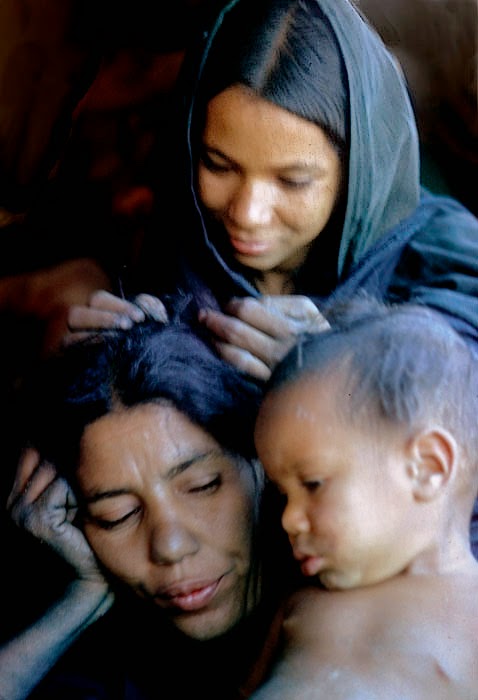For ten years, between 1963 and 1973, I paid repeated visits to the
Tuareg nomads of the Sahara and Sahel, nearly always for several weeks or
months at a time. I did this once for a Venture and Argosy magazine article, three
times for National Geographic articles and book chapters, and once for a
children’s book. I developed friendships with the Tuareg of the Sahara’s Tamesna
plain, Ahaggar Mountains, AÏr Mountains, and of the Sahel’s Azaouak Valley.
To the point that I was everywhere invited into the intimacy of the tents.
In this 1965 picture taken inside a tent, the woman is being deloused by
a niece. Living as close to nature as those people do makes lice inescapable.
And they passed them on to me, though not to worry. Once in a while, in the
middle of a conversation or shoot inside a tent, a woman would grab me by the
hair, pull my head down in her lap, and start a search-and-destroy operation.
My fascination with the Tuareg started in 1957, when at 24 I rode a
small Vespa scooter from Brussels to Cape Town across the length of Africa.
In the Sahara I had to ride inside truck tracks because the sand outside
them was too deep for my small wheels. But veiled Tuareg, their wide robes
inflated by the wind, appeared from nowhere riding white camels to disappear
again beyond any point of the bleak horizon. They became to me the embodiment
of freedom.
Already the father f two, it would take me six years to save enough for my
next African journey and enjoy the first of two thousand-kilometer camel rides,
the second one two years later, with a salt caravan. I owe the Tuareg my career
as a documentary photographer and writer. But in 1973, watching the Tuareg
world disintegrate with the first of two great droughts that would kill many of
my friends and considerably more of their animals, I did not find the heart to
return to their once wonderful world.
To
view more Tuareg photos on this blog, write the word in the search
box.
All
the photographs of this blog are copyrighted.
No
usage permitted without prior authorization.









